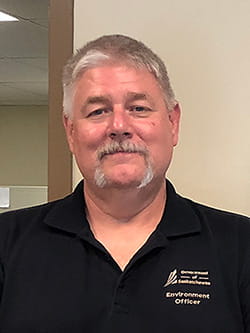Northern Saskatchewan has the biggest high-grade uranium deposits in the world. Almost a quarter of the world’s uranium supply for electrical generation comes from here. And for the last two decades, Tim Moulding has helped Saskatchewan’s uranium production adhere to environmental regulations. As the Northern Region Manager of the Ministry of Environment, he works in the Environmental Protection Branch and makes sure the natural environment is protected and restored. Protecting and restoring means keeping the air, water, land and ecosystems free of unwanted changes.
In 2001, Tim joined the ministry in the northern field office in La Ronge. The Cluff Lake site was still active but nearing the end of its lifecycle.
Basically, mines go through a defined lifecycle from exploration to closure. The Cluff Lake mine was actively mined from 1908 until 2002 with ore being extracted from a combination of open pit and underground mines, all of which fed into a common mill on site. Mining is necessary to gather materials that we need to live our modern lives and it’s comforting to know that it can be done in a way that allows those materials to be gathered while being protective of the land, with the benefit of providing employment and services to areas that may not otherwise have that.
Tim had already overseen this mine, 75 kilometres south of Lake Athabasca, as an Environmental Supervisor. This time, he was involved in all phases: active, decommissioning and reclamation to release. The active stage means the mine is being used. The decommissioning stage means removing the mine areas, mill, tailings and waste areas. The reclamation stage means returning the land to as close to its natural state as possible. With Tim’s help, the Cluff Lake Mine became the first uranium mine to move through the current regulatory processes and to be commissioned under modern environmental standards.
 Tim beams with pride when he talks about it: “I am pleased to be a part of the group that has seen the Cluff Lake site progress through many phases of the life of the mine resulting in the return of the site to a state where it can be safely accessed by area residents and the public.”
Tim beams with pride when he talks about it: “I am pleased to be a part of the group that has seen the Cluff Lake site progress through many phases of the life of the mine resulting in the return of the site to a state where it can be safely accessed by area residents and the public.”
The major decommissioning work on Cluff Lake mine started at the end of 2002 and continued until 2006. Tim was involved in the closure planning and protecting the environment during the decommissioning stage. Tim performed inspections and document reviews and issued environmental approvals. He then oversaw the site's transition monitoring from 2006 to present.
Tim says, “The great thing about the Cluff Lake story is that it really has showcased the utility of the current regulatory framework and how planning with the end in mind is the best way for projects to be sustainable. The assessment phase set the stage for understanding how the project would evolve and was useful for gathering information about the site, the impacts from mining, and how those impacts could be monitored and mitigated with good planning. The monitoring continued through the active mining period and allowed the company and regulators to adjust operations to keep things on track, and the decommissioning work allowed the site to be transformed back into a state very close to what it had been before the mine.”
Thanks to people like Tim who commit their careers to the environment, Cluff Lake is almost back to its natural state.
The ministry expects the decommissioning and reclamation work will be done in September. The mining company will no longer lease or manage the mine land, and it will be public land again. It will be restored public land - where fish, animals and plants in the region are safe to eat; water quality meets environmental standards; and the land is open to Indigenous peoples for traditional use. This is something Tim believes proves the environmental efficiency of the processes the ministry has in place.
